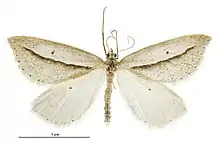Theoxena scissaria
Theoxena is a monotypic moth genus in the family Geometridae erected by Edward Meyrick in 1883.[4] Its only species, Theoxena scissaria, was first described by Achille Guenée in 1868. It is endemic to New Zealand. This species has been classified as nationally vulnerable by the Department of Conservation.
| Theoxena scissaria | |
|---|---|
 | |
| Male | |
| Scientific classification | |
| Kingdom: | |
| Phylum: | |
| Class: | |
| Order: | |
| Family: | |
| Genus: | Theoxena Meyrick, 1883 |
| Species: | T. scissaria |
| Binomial name | |
| Theoxena scissaria | |
| Synonyms[3] | |
| |
Taxonomy
It was described by Guenée in 1868 from a specimen obtained in Canterbury by Richard William Fereday and named Panagra scissaria.[5][3] In 1883 Edward Meyrick placed the species into the newly created genus Theoxena.[6][7] In 1898 and in 1928 George Vernon Hudson also described and illustrated Theoxena scissaria.[8][9] The lectotype specimen is held at the Natural History Museum, London.[2]
Description
Meyrick described the species as follows:
Male. — 23-25 mm. Forewings narrow, hindmargin rather strongly sinuate; dull white, slightly sprinkled with dark fuscous; a curved dark fuscous median streak from inner margin near base almost to apex, sharply defined above, suffused beneath; a black dot in disc, and a row of dots on hindmargin. Hindwings elongate, narrow, apex broadly projecting; white; a blackish dot in disc, and a row on hindmargin.[7]
Distribution
This species is endemic to New Zealand.[2][10] Its range is in North Canterbury, Mid Canterbury, South Canterbury, Mackenzie, Central Otago and Otago Lakes.[11] Other than the type locality, specimens have been collected near the foot of Mount Hutt,[7] the Winchmore Irrigation Research Station near Ashburton,[12] at the lower slopes of Mount Ida in Otago,[13] Horseshoe Slip on Mount Grey,[14] and Ashley Gorge.[9] It is now possibly extinct on the Canterbury Plains.[11]
Life cycle and behaviour
The life history of T. scissaria is still uncertain.[15] Adults have been collected in late winter at the foot of Mount Ida, though none were collected there after August.[13] This species has also been recorded as being on the wing in June,[14] December[9] and January.[7] It is most commonly seen between the months of May and July.[15] A second generation emerges during the summer months.[15] Although T. scissaria has been collected during the day,[14] it is attracted to light.[9]
Habitat
This species frequents plains.[7]
Host species
The host species of T. scissaria is as yet unknown.[15][11] However, this species has been associated with the tussock grass Poa cita.[14] It has been hypothesised that the host species for T. scissaria larvae may be in the genus Carmichaelia.[15]
Conservation status
This moth is classified under the New Zealand Threat Classification system as being nationally vulnerable.[1]
References
| Wikimedia Commons has media related to Theoxena scissaria. |
- Hoare, R.J.B.; Dugdale, J.S.; Edwards, E.D.; Gibbs, G.W.; Patrick, B.H.; Hitchmough, R.A.; Rolfe, J.R. (2017). Conservation Status of New Zealand Butterflies and Moths (Lepidoptera), 2015 (PDF). Wellington, New Zealand: New Zealand Department of Conservation. p. 7. ISBN 9781988514383.
- "Orocrambus sophistes (Meyrick, 1905)". Landcare Research New Zealand Ltd. Retrieved 6 May 2018.
- Dugdale, J. S. (1988). "Lepidoptera - annotated catalogue, and keys to family-group taxa" (PDF). Fauna of New Zealand. 14: 147. Retrieved 6 May 2018.
- Beccaloni, G.; Scoble, M.; Kitching, I.; Simonsen, T.; Robinson, G.; Pitkin, B.; Hine, A.; Lyal, C., eds. (2003). "Theoxena". The Global Lepidoptera Names Index. Natural History Museum. Retrieved May 25, 2019.
- Guenée, A. (1968). "New species of heterocerous Lepidoptera from Canterbury, New Zealand collected by Mr. R.W. Fereday". The Entomologist's Monthly Magazine. v.5=[no.49-60]: 43. ISSN 0013-8908. Retrieved 7 May 2018.
- Meyrick, Edward (1883). "Monograph of New Zealand Geometrina [abstract]". New Zealand Journal of Science. 1: 526–531. Retrieved 7 May 2018.
- Meyrick, Edward (1884). "A monograph of the New Zealand Geometrina". Transactions and Proceedings of the New Zealand Institute. 16: 49–113. Retrieved 7 May 2018.
- Hudson, G. V. (1898). New Zealand Moths and Butterflies (Macro-lepidoptera). London: West, Newman & Co. p. 79. doi:10.5962/bhl.title.7912.
- Hudson, G. V. (1928). The Butterflies and Moths of New Zealand. Wellington: Ferguson & Osborn Ltd. p. 133.
- Gordon, Dennis P., ed. (2010). New Zealand Inventory of Biodiversity. Volume Two. Kingdom Animalia: Chaetognatha, Ecdysozoa, Ichnofossils. Vol. 2. Christchurch, N.Z.: Canterbury University Press. p. 457. ISBN 9781877257933. OCLC 973607714.
- Patrick, B. H.; Dugdale, J. S. (2000). "Conservation status of the New Zealand Lepidoptera" (PDF). Science for Conservation. Department of Conservation, New Zealand. 136: 32. ISSN 1173-2946.
- Wood, J. (1973). "A list of Lepidoptera taken in light traps at Winchmore Irrigation Research Station". New Zealand Entomologist. 5 (3): 284–290. doi:10.1080/00779962.1973.9723023.
- Lewis, J. H. (1900). "Lepidoptera of Mount Ida". Transactions and Proceedings of the New Zealand Institute. 33: 186–187. Retrieved 7 May 2018.
- Hudson, George Vernon (1939). A Supplement to the Butterflies and Moths of New Zealand. Wellington: Ferguson & Osborn. p. 412. OCLC 9742724.
- Patrick, B. (2014). "Winter-emerging moths of New Zealand". The Weta. 48: 8–14.
